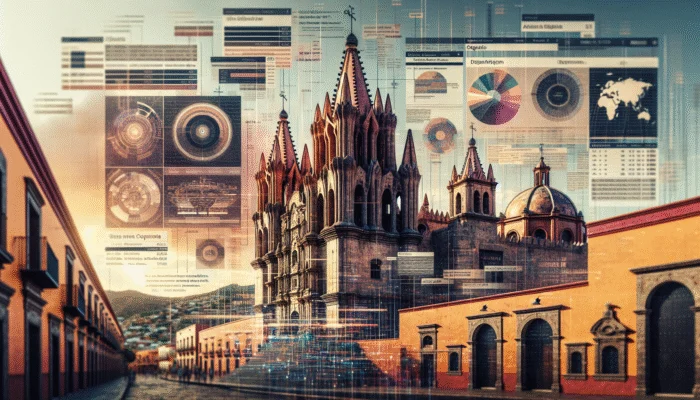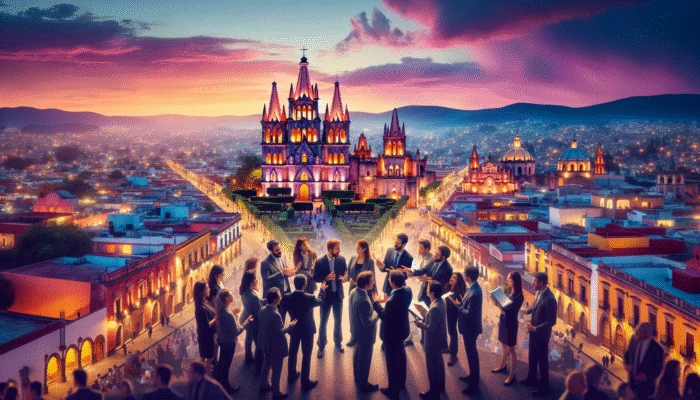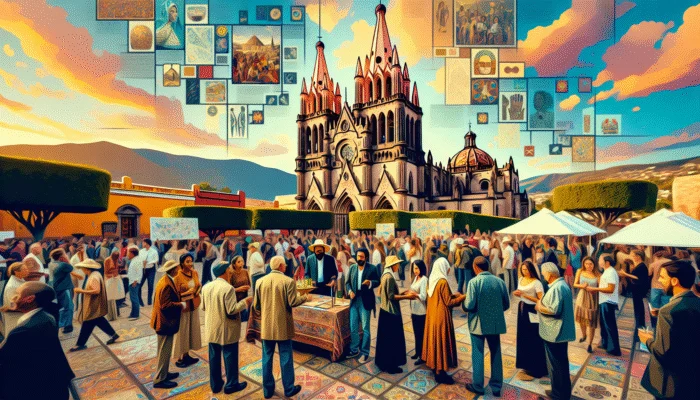Explore the Intriguing Historical Journey of San Miguel de Allende’s Remarkable Cathedrals
Discover the Deep Historical Significance Behind San Miguel de Allende’s Cathedrals

The cathedrals of San Miguel de Allende boast a profound historical narrative that dates back to the transformative 17th century, a period marked by significant changes in both religious practices and cultural expressions in the region. These majestic cathedrals serve not only as essential spiritual havens for the local populace but also as reflections of the socio-political intricacies of their time. Their development is intricately linked to the colonial history of Mexico, where Spanish architectural influences and religious customs became inextricably intertwined with local traditions. Some pivotal historical milestones that define their origins encompass:
- 1542: The establishment of San Miguel el Grande, which necessitated the creation of a central church.
- 1683: The initiation of the construction of the Parroquia de San Miguel Arcángel, exemplifying the exquisite beauty of Baroque architecture.
- 1826: The elevation of San Miguel de Allende to city status, significantly enhancing the prominence of these cathedrals.
- 1900s: Restoration efforts aimed at preserving the architectural integrity of these magnificent structures amid the surge in tourism.
These key historical events illustrate that the cathedrals are not merely places of worship; they are vital elements of the community’s cultural identity and heritage, encapsulating the spirit and storied past of the region.
Explore the Distinct Architectural Styles and Unique Characteristics of the Cathedrals
The architectural styles showcased in the cathedrals of San Miguel de Allende reveal a fascinating fusion of influences that have evolved over centuries. A standout structure, the Parroquia de San Miguel Arcángel, is celebrated for its striking combination of Gothic, Neoclassical, and Baroque styles. The prominent use of pink quarry stone enhances its unique aesthetic, making it an iconic symbol of the city. Key features include:
– Intricate facades embellished with elaborate carvings that showcase the exceptional craftsmanship of the era.
– Tall bell towers that rise majestically above the skyline, reflecting the skills of local artisans.
– Vibrant domes that resonate with the colorful traditions of the local culture.
Each cathedral is also characterized by distinct elements, such as beautifully crafted altarpieces and rich religious iconography that narrate biblical tales, enhancing the visual experience and spiritual journey for visitors.
Understanding the Cultural Importance of San Miguel de Allende’s Cathedrals
The cultural significance of the cathedrals in San Miguel de Allende extends far beyond their stunning architectural beauty. They function as community hubs where religious and cultural life converge. These cathedrals are integral to various local traditions, celebrations, and important life events, which include:
– Fiestas honoring patron saints that attract both locals and international guests.
– Weddings and baptisms conducted within these sacred spaces, which help to strengthen communal bonds and traditions.
– Art exhibits and concerts that take advantage of the cathedrals’ acoustics and ambiance, reaching broader audiences while showcasing local culture.
Thus, the cathedrals embody a living history, playing an active role in the community’s cultural narrative and celebrating its vibrant heritage through a variety of social activities.
Expert Perspectives on the Remarkable Cathedrals of San Miguel de Allende

What Distinguishes These Cathedrals from Others Worldwide?
The distinctive nature of the San Miguel de Allende cathedrals lies in their multifaceted character, seamlessly blending architectural brilliance with profound cultural significance. Unlike many cathedrals around the world, these structures exhibit a unique local flair, rooted in the use of traditional materials and construction techniques that authentically reflect the region’s essence. The Parroquia de San Miguel Arcángel, for instance, is particularly famous for its captivating pink stone façade, which sets it apart in the global context of ecclesiastical architecture.
To truly appreciate these unique characteristics, visitors are encouraged to:
– Join guided tours that offer valuable insights into the historical background and architectural details.
– Participate in local events hosted within the cathedrals to witness their ongoing relevance in contemporary society.
– Explore surrounding artworks and sculptures that enhance the architectural beauty of the cathedrals.
Engaging in these activities guarantees a comprehensive understanding of what makes these cathedrals a vital part of San Miguel de Allende’s cultural heritage.
What Preservation Challenges and Efforts Are Currently Underway?
The preservation of the historical authenticity of the San Miguel de Allende cathedrals is a continual endeavor that confronts various challenges. Local authorities and heritage organizations are actively involved in restoration initiatives aimed at maintaining these architectural wonders while addressing contemporary pressures. The success of these preservation efforts can be seen in the careful restoration of damaged areas and the establishment of protective regulations.
Despite these efforts, challenges persist, such as the increasing tourism pressure, which can result in the deterioration of these historical structures. In addition, funding limitations often restrict the scope of extensive restoration projects. Experts advocate for a balanced approach that respects the cathedrals’ historical context while adapting to modern needs. Involvement from the local community in preservation efforts is essential to ensure these cathedrals remain significant and well-maintained for future generations.
How Are Cathedrals Adapting to Modern Society?

The San Miguel de Allende cathedrals have evolved from being solely traditional places of worship into dynamic, multifunctional spaces that meet a variety of community needs. Their influence now transcends spiritual practices; they have become crucial venues for cultural exchange, education, and tourism.
In today’s landscape, these cathedrals host a diverse range of events, from art exhibitions to community gatherings, reflecting the changing social dynamics. Local artists frequently collaborate with cathedral management to showcase their work, fostering community ties while promoting local talent. This transformation exemplifies the adaptability of the cathedrals and their ability to resonate with both local inhabitants and visitors alike.
Exploring the Depth of Architectural Influences and Styles
An in-depth examination of the architectural influences that characterize the San Miguel de Allende cathedrals unveils a complex interplay of cultural and historical elements. The Baroque features seen in the Parroquia de San Miguel Arcángel are particularly striking, marked by ornate details and dramatic contrasts that were significant during the colonial era.
Furthermore, the Neoclassical elements found in various structural components mirror the broader European influences that permeated Latin America during the 18th and 19th centuries. Experts argue that the harmonious fusion of these styles not only enhances the cathedrals’ aesthetic appeal but also narrates a historical story, illustrating the evolution of architectural trends in response to local conditions and cultural shifts.
Acknowledging this architectural diversity provides valuable insights into how these cathedrals have adapted over time, ensuring their significance while maintaining their historical essence.
Encouraging Community Involvement Through Events
Community engagement is vital in keeping the San Miguel de Allende cathedrals relevant in contemporary society. These structures serve not only as places of worship but also as integral parts of community life, frequently hosting various events that strengthen social connections.
For example, the cathedrals often serve as venues for cultural festivals, art exhibitions, and educational programs designed to promote local customs and traditions. Such events encourage participation from both residents and tourists, creating an inclusive environment that celebrates cultural diversity. Furthermore, workshops and seminars covering topics from art to history frequently take place within these sacred spaces, further cementing their role as centers of learning.
The impact of community engagement initiatives is profound; they not only enrich local culture but also nurture a sense of belonging among residents, reinforcing the cathedrals’ status as essential pillars of the community.
Understanding the Maintenance Practices for the Cathedrals of San Miguel de Allende
Assessing Maintenance Techniques and Materials Utilized
Maintaining the San Miguel de Allende cathedrals demands meticulous attention to detail, employing specialized techniques to ensure their historical integrity is preserved. Routine maintenance practices encompass regular inspections to identify areas in need of repair, careful restoration of decorative features, and the application of protective treatments to prevent deterioration over time.
Key maintenance techniques include:
- Restoration of plaster and frescoes using traditional methods that respect original craftsmanship.
- Regular cleaning of stone facades to eliminate pollutants that can cause damage.
- Application of weather-resistant coatings on vulnerable surfaces to prolong their lifespan.
- Conducting structural assessments to mitigate potential harm from environmental factors.
These practices are crucial for ensuring that the cathedrals not only maintain their visual allure but also withstand the test of time against various environmental challenges.
What Financial Aspects Are Involved in Cathedral Maintenance?
The upkeep of the San Miguel de Allende cathedrals involves various financial considerations that are critical to the overall preservation efforts. The associated costs can be considerable, typically encompassing routine maintenance as well as extensive restoration projects.
Funding sources for these initiatives often comprise government grants, private donations, and community fundraising efforts. Annually, maintenance costs can vary significantly based on the scope of work required, but standard expenses may include:
– Routine cleaning: Approximately $10,000 each year dedicated to professional cleaning services.
– Restoration projects: Major restorations can exceed $100,000, depending on the extent of damage.
– Staffing: Hiring conservation specialists may necessitate an additional $50,000 annually.
Understanding these financial components is essential for stakeholders involved in cathedral maintenance, emphasizing the importance of ongoing investment in the preservation of cultural heritage.
In What Ways Does the Community Contribute to Cathedral Maintenance?
Local communities play a pivotal role in the maintenance and preservation of the San Miguel de Allende cathedrals. Community-driven initiatives not only assist in the upkeep of these sacred spaces but also cultivate a sense of ownership among residents. Volunteer groups often organize efforts to clean and restore various sections of the cathedrals, contributing hands-on support to the preservation mission.
For instance, local schools may engage students in educational programs that include field trips to the cathedrals, where they learn about their history while participating in clean-up activities. Such initiatives strengthen the bond between the community and its cultural heritage, ensuring that the cathedrals remain significant and cherished.
Moreover, fundraising initiatives led by community members frequently target specific restoration projects, ensuring a steady influx of resources dedicated to the maintenance of these crucial cultural landmarks.
Understanding Government Regulations and Oversight for Preservation
Government regulations are essential for the preservation of the San Miguel de Allende cathedrals, providing a framework that ensures their integrity while facilitating necessary restoration efforts. Local and national laws often mandate the protection of historical sites, ensuring that any alterations adhere to preservation standards.
These regulations may encompass:
– Heritage designations that recognize the cathedrals as significant cultural landmarks.
– Building codes that govern restoration practices to ensure historical accuracy.
– Funding allocations dedicated to preservation efforts through governmental heritage programs.
Such oversight not only protects the cathedrals from inappropriate modifications but also enhances their appeal as tourist attractions, reinforcing their significance to local communities and the broader cultural landscape.
What Is the Impact of Tourism on Cathedral Maintenance?
Tourism exerts a substantial influence on the maintenance strategies for the San Miguel de Allende cathedrals, presenting both opportunities and challenges. On one hand, the influx of visitors generates essential funding through entrance fees, donations, and local spending, which can be allocated towards maintenance efforts.
Conversely, the increased foot traffic can lead to accelerated wear and tear, necessitating more frequent maintenance and repair work. For instance, a high volume of visitors may result in:
– Increased cleaning and restoration costs due to environmental pollutants and general wear.
– Enhanced security measures to protect against vandalism and theft.
– Community programs aimed at educating visitors about responsible tourism practices.
Striking a balance between tourism and the preservation of these cathedrals is crucial; effective strategies are necessary to mitigate adverse impacts while capitalizing on the benefits that tourism brings to the community.
Artistic Features Enriching the Cathedrals of San Miguel de Allende
What Stained Glass and Mosaic Artworks Are Present in the Cathedrals?
The incorporation of stained glass and mosaic artworks within the San Miguel de Allende cathedrals reveals a captivating dimension of their artistic importance. These elements not only enhance the visual allure of the spaces but also serve significant spiritual and cultural purposes. The intricate designs featured in stained glass windows often illustrate biblical narratives, injecting vibrant colors into the interiors that shift with the light, creating a dynamic and contemplative environment.
Noteworthy examples include windows honoring local saints and commemorating pivotal historical events for the community. In contrast, mosaics frequently embellish altars and chapels, showcasing local craftsmanship and artistic heritage. The artistry in these pieces reflects a rich blend of indigenous and colonial influences, forming a unique representation of the region’s cultural identity.
The artistic significance of these installations cannot be undervalued; they invite reflection and foster deeper connections for visitors with the spiritual narratives they embody.
How Does Religious Art Enhance the Spiritual Experience?
Religious art within the San Miguel de Allende cathedrals serves as a powerful medium for expressing spirituality and reinforcing community identity. This art substantially enriches the worship experience, providing visual narratives that deepen congregants’ connections to their faith and enhance liturgical practices.
Key aspects of religious art include:
– Iconography that educates congregants about saints and biblical stories.
– Cultural storytelling that reflects local history and fortifies community ties.
– Aesthetic appeal that transforms the worship environment into a space of beauty and reflection.
Additionally, the presence of religious art shapes visitor experiences, prompting introspection and dialogue regarding faith and culture. These artworks amplify the cathedrals’ spiritual significance while serving as a bridge between the past and the present.
Analyzing the Role of Sculptures and Statues
The presence of sculptures and statues within the San Miguel de Allende cathedrals adds layers of historical and artistic value to these sacred spaces. Each figure, whether representing a revered saint or a notable historical figure, conveys a narrative that often reflects the religious and cultural ethos of the community.
Statues are typically crafted from locally sourced materials, demonstrating artisans’ skills as they blend traditional techniques with contemporary expressions. These works serve multiple purposes:
– Visual focal points that capture attention and invite contemplation.
– Cultural markers that signify important local figures and historical events.
– Educational tools that provide insights into the region’s spiritual heritage.
The rich tapestry of sculptures and statues within these cathedrals not only enhances their visual appeal but also reinforces their significance as vital cultural landmarks, preserving the narratives and values of the community.
Research-Backed Benefits of the San Miguel de Allende Cathedrals
In What Ways Do Cathedrals Support Mental Well-being?
The San Miguel de Allende cathedrals provide numerous mental health benefits, rooted in the calming and reflective environments they create. Research indicates that spending time in sacred spaces can elevate feelings of tranquility and well-being, contributing to reduced stress levels and enhanced mental clarity. The serene atmosphere and beautiful surroundings foster a sense of calm that can be therapeutic for both locals and visitors.
Real-world examples of these benefits include:
– Meditation services held within the cathedrals that encourage mindfulness and stress relief.
– Art therapy programs that utilize the inspiring environment of the cathedrals to facilitate healing through creativity.
– Community support groups that convene in these spaces, leveraging their calming presence for discussion and fellowship.
Engaging with the spiritual and artistic aspects of the cathedrals significantly enhances mental health, providing a sanctuary amidst the fast-paced nature of modern life.
What Educational Opportunities Are Offered by the Cathedrals?
Visiting and studying the San Miguel de Allende cathedrals presents considerable educational advantages, rendering them invaluable resources for both locals and tourists. These cathedrals function as dynamic classrooms where history, art, and culture converge. Key educational aspects include:
- Gaining insight into the historical context of colonial Mexico.
- Exploring architectural styles and their evolution over time.
- Learning about local customs and traditions through guided tours.
- Participating in community workshops and lectures that deepen engagement with cultural heritage.
The educational experiences provided by these cathedrals cultivate a greater appreciation for cultural heritage and encourage critical thinking regarding the intersection of religion and society.
What Economic Impact Does Cathedral Tourism Have?
The economic implications of cathedral tourism on the San Miguel de Allende community are significant, contributing to local economies through various channels. The influx of visitors eager to explore these historical sites stimulates spending across multiple sectors, including hospitality, retail, and services.
Expert analyses indicate that cathedral tourism generates substantial revenue, supporting jobs and local businesses within the area. For instance, each visitor may spend an average of $100 per day on accommodations, dining, and souvenirs, resulting in millions of dollars annually for the local economy. Furthermore, the preservation efforts funded by tourism revenue ensure the ongoing maintenance of these architectural treasures, reinforcing the symbiotic relationship between tourism and heritage conservation.
What Are the Best Practices for Visiting the San Miguel de Allende Cathedrals?
Smart Strategies for Organizing Your Visit
Carefully planning a visit to the San Miguel de Allende cathedrals enhances the overall experience. Best practices for visitors include:
- Researching cathedral opening hours and service schedules to effectively plan your visit.
- Booking guided tours in advance for deeper insights into the history and architectural details.
- Checking for any special events or festivals that may coincide with your visit.
- Dressing appropriately for the cathedral environment, reflecting respect for its sacredness.
By adhering to these guidelines, visitors can maximize their enjoyment and appreciation of these remarkable cultural landmarks.
What Etiquette Should Visitors Follow Before Entering?
Visitors should be aware of specific etiquette and guidelines that enhance the communal experience prior to entering the San Miguel de Allende cathedrals. Important considerations include:
– Dress code: Modest attire is encouraged to demonstrate respect for the sacred space.
– Silence: Maintaining respectful quietness is crucial, especially during services.
– Photography policies: Many cathedrals have restrictions on photography, so it is wise to inquire beforehand.
– Behavior: Visitors should be conscious of their conduct, remembering that these are places of worship.
Understanding these expectations fosters a respectful atmosphere that honors the spiritual significance of the cathedrals.
What Opportunities Are Available for Guided Tours and Educational Programs?
Guided tours and educational programs at the San Miguel de Allende cathedrals significantly enhance the visitor experience by providing structured insights into their history, architecture, and cultural significance. Numerous reputable tour operators offer comprehensive packages that include:
– Expert-led discussions on architectural styles and historical contexts.
– Interactive workshops that delve into the artistry and techniques utilized in the cathedrals.
– Specialized tours focusing on religious art and its impact on local culture.
These programs are designed not only to educate but also to foster a deeper connection between visitors and the cultural heritage embodied by the cathedrals, ensuring a more meaningful visit.
Envisioning the Future of San Miguel de Allende Cathedrals
How to Harmonize Modernization with Preservation
The future of the San Miguel de Allende cathedrals rests at the juncture of modernization and preservation, an ongoing conversation as stakeholders navigate the challenge of maintaining historical integrity while accommodating contemporary needs. Advocates for modernization propose integrating new technologies and amenities to enhance visitor experiences, while preservationists highlight the importance of preserving the cathedrals’ historical essence.
Expert analyses indicate that achieving balance is crucial. Potential developments may include:
– Enhanced visitor facilities that harmonize with architectural aesthetics.
– Digital engagement tools that educate visitors without compromising historical integrity.
– Collaboration with conservationists to ensure that modernization efforts honor the cathedrals’ heritage.
The path forward will require careful deliberation and cooperation among stakeholders to ensure these cherished landmarks continue to thrive for future generations.
What Role Will Technology Play in the Future?
Technology is set to play a significant role in shaping the future of the San Miguel de Allende cathedrals, offering innovative solutions for preservation and visitor interaction. Current technological integrations include:
– Augmented reality applications that provide immersive historical experiences.
– Digital restoration techniques that facilitate precise conservation efforts while minimizing physical intervention.
– Online donation platforms that streamline funding for maintenance and restoration initiatives.
By embracing technology, the cathedrals can enhance their appeal to younger audiences while ensuring their longevity and importance in an increasingly digital world.
How Can Community Engagement Shape Future Projects?
Looking ahead, community involvement will be pivotal in shaping future projects related to the San Miguel de Allende cathedrals. Gathering community feedback is essential to ensure that any developments align with local values and aspirations. Collaborative initiatives may encompass:
– Public forums to discuss proposed projects and gather community input.
– Volunteer programs that allow local residents to participate in restoration efforts.
– Educational outreach to raise awareness about the importance of preserving cultural heritage.
Engaging the community in planning and execution fosters a sense of ownership and pride, ensuring that the cathedrals remain treasured symbols of San Miguel de Allende’s rich cultural legacy.
Frequently Asked Questions About the Cathedrals of San Miguel de Allende
Which Cathedral Is the Most Renowned in San Miguel de Allende?
The most renowned cathedral in San Miguel de Allende is the Parroquia de San Miguel Arcángel, famous for its breathtaking pink façade and Gothic architectural features.
Are the Cathedrals Accessible to the Public?
Yes, the cathedrals are generally open to the public, with designated visiting hours. Certain areas may have restrictions during religious services.
When Is the Optimal Time to Visit the San Miguel de Allende Cathedrals?
The optimal time to visit is during the dry season, typically from November to April, when the weather is ideal for exploration.
Can Visitors Participate in Services at the Cathedrals?
Yes, visitors are welcome to attend services at the cathedrals. It is advisable to verify the schedule and arrive early for seating.
Are Guided Tours Available?
Yes, guided tours are available, offering insightful historical context and details about the architecture and art within the cathedrals.
Is Photography Permitted Inside the Cathedrals?
Photography policies vary; some areas may allow it, while others may impose restrictions during services. Always check signage or consult staff.
What Cultural Events Are Held at the Cathedrals?
Cultural events such as fiestas, art exhibitions, and community gatherings are frequently organized at the cathedrals, highlighting local traditions.
How Can I Contribute to the Maintenance of the Cathedrals?
Contributions can be made through donations, participation in community restoration activities, or support for local fundraising initiatives.
What Is the Historical Significance of the Cathedrals?
The cathedrals embody significant cultural and religious heritage, reflecting Mexico’s colonial history and the identity of the local community.
Are the Cathedrals Accessible for Individuals with Disabilities?
Accessibility varies; some areas may accommodate individuals with disabilities, while others may present challenges. It is best to inquire in advance.
The Article: Cathedrals of San Miguel de Allende: Your Ultimate Guide appeared first on https://fallinginlovewithsanmiguel.com/
The Article Cathedrals in San Miguel de Allende: The Complete Guide Was Found On https://limitsofstrategy.com

